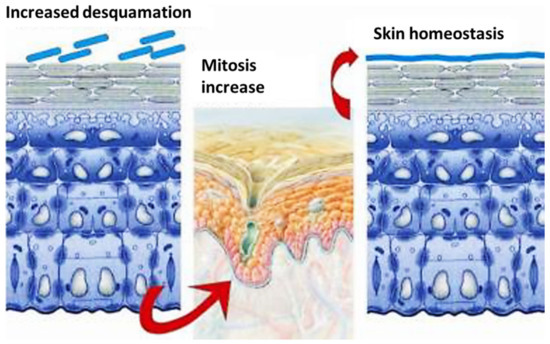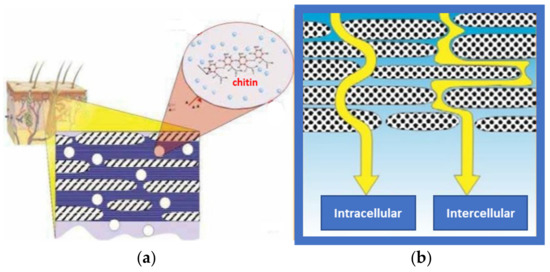Beauty and personal care became a significant part of the global economy for two reasons: (1) The elderly growing in the global population and (2) the desire of women and men to appear younger and more attractive. Thus, both young and old people are looking for revolutionary nutritional eco-cosmetics (combined use of cosmeceuticals and nutraceuticals) manufactured by natural active ingredients, using biopolymers as substrates, and made by innovative and sustainable technologies. Consequently, the market of both cosmetics and diet supplements is continually growing together with the request of natural active ingredients, including bio-peptides and biological macromolecules such as chitin and lignin. Therefore, both consumers and industry need to recover innovative active ingredients and carriers (vehicles), naturally derived and supported by advanced methods for controlling their effectiveness and safeness on skin and mucous membrane layers. The use of selected bio-ingredients, such as hyaluronic acid and bio-mimetic peptides, obtained by advanced, innovative and sustainable bio nanotechnologies, will be of interest to develop smart cosmeceutical and nutraceutical formulations. Innovation is considered the key business strategy to drive sustainable economic growth. For trying to reduce waste and produce sustainable, biodegradable and innovative products, the realization of new non-woven tissues, used as carriers for making innovative cosmeceuticals and nutraceuticals was considered. Both carriers and active ingredients have been obtained from food waste to reduce loss and pollution.
- biopeptides
- biomimetic peptides
- cosmeceuticals
- cosmetics
- : cosmetics
1. Introduction
2. Active Ingredients of Bio-Nanotechnology
The market for active ingredients for both cosmetics and beauty diet supplements is increasing year by year [1][2][1,2]. Thus, consumers and companies, looking for the best way to address a younger appearance try to find more effective formulations that are able to restore a healthy prematurely aged or altered skin [11][12][25,26]. As a result, it is essential to focus more studies on recovering active ingredients that can be used to make innovative cosmeceuticals and nutraceuticals, which are effective and safe for both skin health and the environment [13][14][15][27,28,29]. To this end, many scientific research studies have been oriented to the use of nano biotechnology-derived ingredients. With bio-nanotechnology, it seems possible to develop innovative compounds, new delivery systems and tools, which are able to control the product effectiveness and safeness at the level of the cell biology through new smart techniques, including the molecular biology, recombinant DNA, and gene and microbiome regulations [13][14][15][27,28,29]. New active micro-nano ingredients were, therefore, recovered and applied to different biological systems, including skin and mucous membranes, for overcoming the various biological barriers by the use, for example, of dermal and transdermal delivery systems [16][17][18][19][30,31,32,33]. Some active ingredients, such as chitin nanofibrils(CN) and nanolignin (NL), may be diffused by nanocarriers, such as liposomes, niosomes, innovative nanovesicles, matrices, nanocomposites and nanoparticles applied to biological systems, for example by electromagnetic fields [16][17][18][19][30,31,32,33].
However, what does bio-nanotechnology mean? It “is the branch of nanotechnology with biological and biochemical applications”, including the use of biomolecules as part of nanotechnological devices, supported by mathematic, physic, engineering, computer science and information technology [20][34]. This new branch of science, therefore, is currently developing environmentally-friendly processes that produce zero waste and low consumption of water and energy, which are requirements for obtaining a cleaner and healthier planet. Thus, in the sector of nutritional eco-cosmetics (used topically or by oral route), bio-nanotechnology is playing an important role, ameliorating performance and bioavailability of the active ingredients, which, for example, encapsulated or adsorbed on the surface of nanoparticles, might enhance their penetration through skin or mucous membranes [21][35].
3. Natural Ingredients Used in the Medical, Cosmetic and Diet Supplement Field
As examples, among the ingredients of more common use are: Ascorbic acid (vitamin C), utilized for its antioxidant properties in the pigment-lightening formulations together with alpha lipoic acid, arbutin and Kojic acid [22][42]; aloe vera, which finds applications for its antibacterial, antiviral and immune modulating effectiveness [23][43]; grape seed oil, used as anti-aging agent thanks to its antioxidant and healing properties [24][44]; and green and black tea rich in antioxidant and antibacterial molecules, which are also able to inhibit the virus entry [25][45]. Some selected natural ingredients of common use in the cosmetic field and obtained from waste, micro algae and bacteria are reported in Table 1 as an example [26][27][28][29][30][31][32][33][34][35][36][46,47,48,49,50,51,52,53,54,55,56], while the more used ones, such as hyaluronic acid, oligopeptides, biomimetic peptides and collagen, are described reporting their supposed mechanism of action.| Bioingredients | Source | References |
|---|---|---|
| Flavonoids, polyphenols | fruits, vegetables, cereals (Coffee, tomato, rice, etc.) | [27][28][29][47,48,49] |
| Salicilic/cinnamic acid | Aloe vera plant | [30][50] |
| Tocopherols/FFA | Argania Spinosa oil | [31][51] |
| Chitin | Crustaceans, fungi, insects | [32][52] |
| Lignin | Agro and forestry waste | [32][52] |
| Vitamin b and C, minerals | Potato | [33][53] |
| Cannabinoids, terpenes | Cannabis sativa | [34][54] |
| Minerals, proteins | Microalgae | [35][36][55,56] |
4. Structure of Skin
On the surface of our body, the skin provides a protective barrier offering thermal insulation, preventing water loss and repairing against the external aggressions, including toxic and irritant micro-nanoparticles, microorganisms, ultraviolet [UV] irradiation and allergens [37][96]. This organ, generally less than 2 mm thick, is divided into three anatomically distinct viable layers—epidermis, dermis and hypodermis—covered by the non-viable stratum corneum (SC) that plays an important role in skin protection and hydration (Figure 15) [37][96].


5. Skin Penetration and Supposed Mechanism of Action of Carriers/Active Ingredients
It is necessary to remember the different skin penetration modalities, achievable through three pathways -intercellular, intracellular and trans-follicular. They depend on the barrier disruption area and frequency of application, the degree of friction or rubbing of the product onto its surface and naturally to the composition of carrier and the selected active ingredients (Figure 37) [43][44][45][105,106,107]. The primary purpose of the carrier, in fact, is to enable the cosmetic active ingredients to be conveniently spread upon the skin for their better penetration through its layers. Consequently, composition and physicochemical characteristics of the carriers represent an important instrumental role of the products’ activity, which depends principally on the scaffold porous material used to make the carrier structure. The product effectiveness and safeness, in fact, are determined by the intrinsic activity of the selected active ingredients and the capacity of the carrier to deliver them at the right skin or mucous membrane layers [43][44][45][105,106,107].
The carrier, mimicking the skin ECM, may perform its essential functions, such as anchorage, proliferation and migration of the cells [46][47][48][108,109,110]. Thus, for example, the right porosity of the carrier-tissue permits growth and migration of the cells, which, through its pores, may have not only the necessary oxygen and nutrients but also the possibility to eliminate the waste materials [46][108]. This is the reason why many scientific research studies have been published during the last years on the topic of carriers and nanocarriers, including micro/nano emulsions, liposomes, lipid nanoparticles and polymeric nanocomposites, all realized with the aim to overcome the skin’ penetration problems [44][45][46][47][48][49][50][51][101,106,107,108,109,110,111,112].
Regarding the delivery of nutraceuticals, they can be administered by the same water-soluble carrier-tissues through the trans-mucosal sublingual route [52][129]. The oral mucosa, in fact, is characterized by a high permeability and capability to bypass the first-pass metabolism of liver. Thus, the active ingredients may slowly diffuse into the systemic circulation in a relatively short time, avoiding their distraction by the gastric juices [53][54][55][130,131,132]. Therefore, the necessity to realize specialized nano-carriers able to traverse this thick web, evading adhesion to the sticky mucin fibers [56][57][58][133,134,135]. Just for trying to better understand the problem, it is interesting to remark that mucosa, covered by an adhesive gel, the mucus, is composed of a density network of natural mucin polymers [52][53][54][59][128,129,130,131]. These macromolecules, interspersed with a variety of glycoproteins made by about 10 carbohydrate side chains, create a selective barrier to the diffusion of other macromolecular systems across mucosal surfaces [43][57][105,134].
